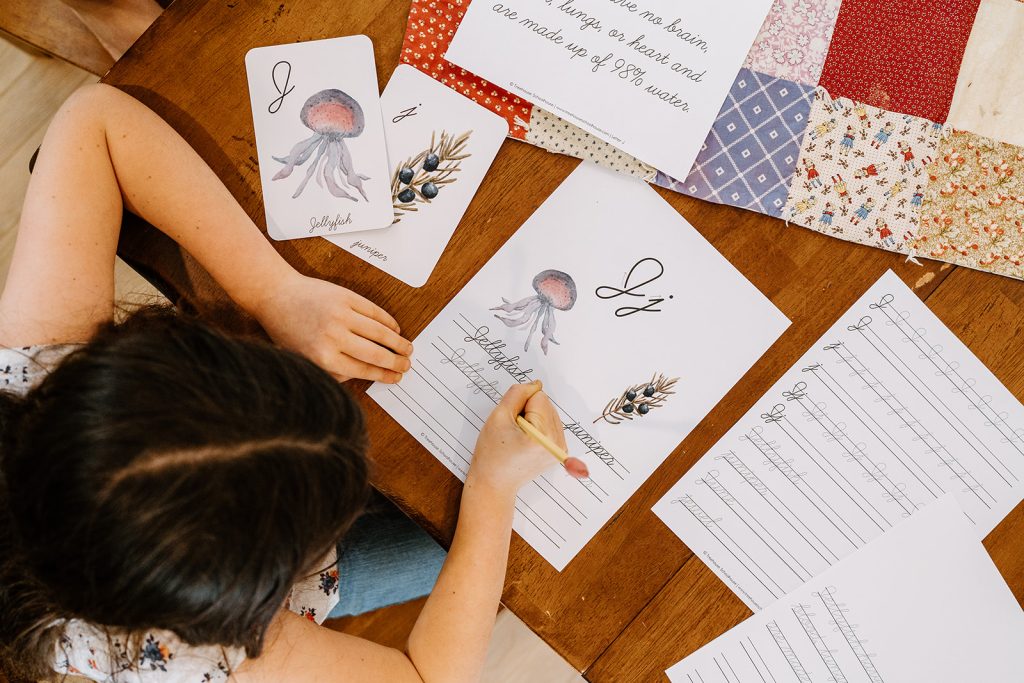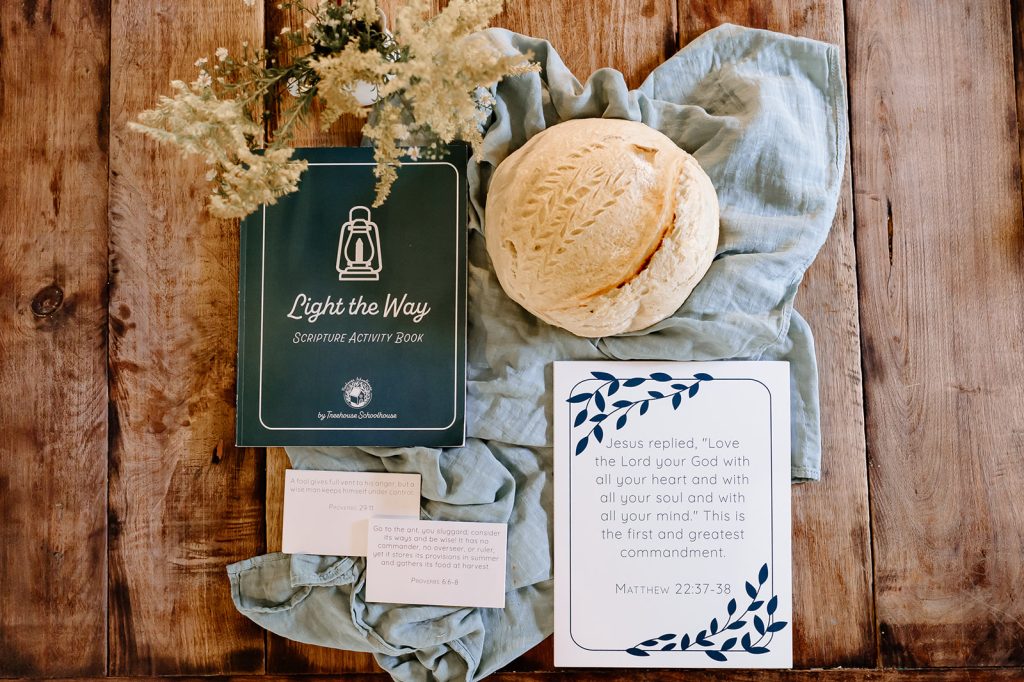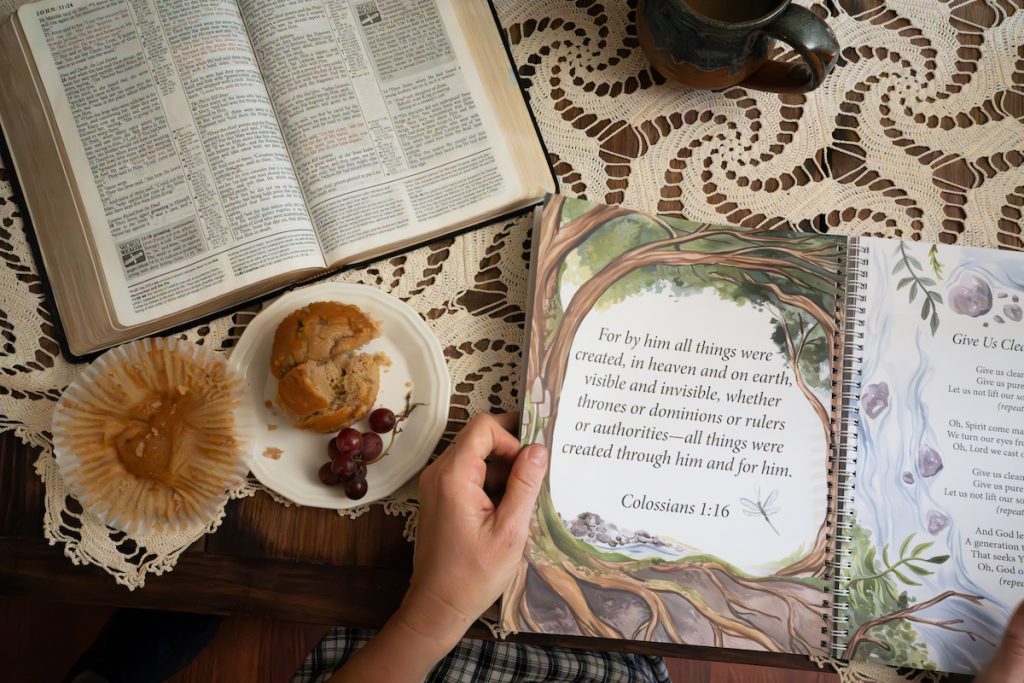When I first learned about copywork, I was unimpressed. I thought it seemed too basic and simple, especially when I read that it “covers” so many subject areas within language arts and may even replace requiring a formal spelling, grammar, and handwriting curriculum. It seemed too good to be true. But we gave it a shot and saw the fruit of it quickly. Now, copywork is a part of our children’s daily schooling from the time they start to write. The children enjoy it, especially when they are copying something they connect with like excerpts of Scripture, nature poetry, or lines from their favorite books.
In this blog post:
- Benefits of using copywork in your homeschool?
- How to incorporate copywork in your homeschool
- How to do copywork with different ages
- How we are currently using copywork in our homeschool
- Copywork resources from Treehouse Schoolhouse
Benefits of using copywork in your homeschool

Copywork is a long-standing practice in education. In the Charlotte Mason philosophy, copywork is a method of practicing writing skills. Students practice copying words from a passage of literature or other writing source to learn and practice handwriting and letter formation. It helps students develop vocabulary, improve reading and writing, and learn how punctuation is used. Copywork is a way to gently encourage and integrate formal writing skills. The goal is for children to absorb other learning through the habit and practice of copywork – consuming great literature and advancing their skills as they work through different passages.
How to incorporate copywork in your homeschool

Incorporating copywork in your homeschool does not require any formal curriculum. How you choose to implement this will vary based on the age or skill level of your child. In general, adding copywork requires having a source for your children to copy from, whether that is a few letters or words, a poem, or a selection of literature. You will also want a blank lined paper, chalkboard, or dry-erase board for your child. We also like to use menu covers with lined sheets of paper and dry-erase markers.
There are so many ways to go about this. You can easily tailor it to the interests and abilities of your child. While there are many formal copywork “curriculum” options, all you really need to add copywork to your homeschool is a writing source and blank lined paper that suits your children’s skill level, like these lined pages for kindergarten, these for primary grades, or these for intermediate.
These are my favorite paper options for different ages:
How to do copywork
1. Display a handwriting sample
Show your child a letter, word, sentence, poem, or passage to copy from. In the younger years, direct your child to copy it in the exact proper handwriting form. This may mean you demonstrating how to write it first on the same paper they will copy on.
In upper elementary grades, children can copy straight from books and rewrite the passage in print or cursive in proper form, even if the original text is not the same.
2. Invite your child to copy the sample
Ask your child to copy the sample onto lined paper. Quality is more important that quantity in copywork, so encourage excellence and allow them to stop when their form is being compromised.
3. Compare your child’s copywork to the original text
Sit with your child as they copy and evaluate their work with the original sample, side by side. If any corrections need to be made, show your child the differences and ask them to correct any errors right away, so as not to form wrong habits in their writing. If needed, allow them to complete the work first, and then check it for corrections.
How to do copywork with different ages
How to use copywork in preschool and kindergarten

For the early years, loosely ages 3-6, my focus is on letter recognition and letter formation. Focusing on one letter at a time, children will learn the proper way to shape and form letters. My children use the Wonder of Nature Alphabet Sheets with a menu cover and dry-erase marker to practice forming one letter at a time. At this age, we will pair this with other hands-on learning like forming letters with Play-Doh or matching upper and lowercase letters with alphabet cards. If my child is interested in copywork at this age, I may write a few words on a whiteboard or piece of writing paper in proper print letter formation and invite them to copy it. Because so much of our learning is family-style, if my older children are copying an entire passage of scripture or a poem, my young child may just copy a few words from the same passage.
How to use copywork in early elementary

When children are confident in the formation of the letters of the alphabet, we begin daily copywork of words, sentences, or short poems. This is usually around age 6 or 7 and only in print. While using Rooted Family Bible Curriculum, or unit studies like An Expectant Easter or A Connected Christmas, they copy the Bible verses they are memorizing. On weeks that we study themes from Treehouse Nature Study, they copy a portion or all of the week’s nature poem. Other times, I simply grab a poetry book or literature we are reading and they copy a sentence or two from there. The emphasis is on excellence in their writing, not speed or quantity.
How to use copywork for upper elementary

In upper elementary, around age 8, I transition to teaching cursive writing and copying longer selections of Scripture, poetry, or literature. While the children still do a good amount of copywork in print, we alternate between print and cursive to ensure their skills stay sharp.
Much like early elementary, we pull copywork from various subjects we are studying. My older children focus on copying long-form writing passages like the entire poems offered each week in Treehouse Nature Study, Primary Years, longer passages of Scripture, or paragraphs from literature. I may let them choose the passage or I may suggest one myself.
How we use are currently using copywork in our homeschool

This year in our homeschool we are focusing on copywork in a few ways.
My younger two children are using the Wonder of Nature Alphabet Sheets to practice letter formation. My kindergartener will also copy a few words from a poem, scripture, or declaration when he is interested. Sometimes he also wants to join in on Mail Monday and I will write what he says and he will copy it to send to a friend or grandparent.
We also use Treehouse Nature Study, Primary Years year-round for my whole family. Each week my older children copy the poem in print and cursive. Along with this, my older two children are using Wonder of Nature Cursive Copywork to review their cursive skills and practice daily in their independent work block. In the past, we have used Light the Way and Nature Poetry Collection for daily print copywork practice.
Copywork resources from Treehouse Schoolhouse
Many learning resources from Treehouse Schoolhouse include copywork as a gentle invitation to enhance learning.
Wonder of Nature Cursive Copywork

Wonder of Nature Cursive Copywork is a cursive resource that offers nature-themed vocabulary, literary quotes, poetry excerpts, facts, and even a few jokes as the source for copywork.
Light the Way Scripture Memory Set

Light the Way is a Scripture memorization set that includes copywork sheets and memory verse cards that children can easily use as a source to copy while they are learning Bible verses.
Rooted Family Bible Curriculum

Rooted Family Bible Curriculum includes a weekly poem, hymn, Bible verse, and declaration. Children can use any of these for copywork, but the guide specifically prompts you to use the scripture and poem as sources for copying each week.
Treehouse Nature Study

Treehouse Nature Study is a year-round nature study curriculum that includes a nature poem that aligns with each week’s theme.
In addition, holiday unit studies from Treehouse Schoolhouse like An Expectant Easter, A Connected Christmas, and A Connected Christmas: Around the World all include coordinating Scripture and poems that are excellent selections for copywork practice. Nature Poetry Collection includes 20 favorite nature poems for children with coordinating lined pages for copywork.
Do you use copywork in your homeschool? Share your thoughts in the comments below.




![Why Kids Should Still Read Fairy Tales Today [Free Booklist]](https://storage.googleapis.com/treehouse-schoolhouse-media-dev/8901dcb1-img_6905.jpg)